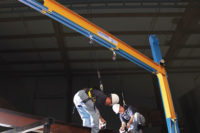But despite the increasing sales of fall protection products, the number of fall-related injuries continues to grow. Why? The lack of proper training is one reason. Others are the selection of the wrong equipment for a particular application, and the failure of a user to wear the equipment properly.
One additional important, yet often overlooked, factor is this: all fall protection equipment deteriorates with use and exposure over time, regardless of brand or manufacturer. The problem is that fall protection equipment on many worksites is not inspected often enough for wear and damage. In order to maintain their integrity and service as a life-saving safety solution, personal fall arrest system components — anchorage connectors, body wear and connecting devices — must be systematically inspected and maintained.
Harness (and body belt) inspection
To inspect your harness or body belt, perform the following procedures.
1) Webbing – Grasp the webbing with your hands 6 inches (152 mm) to 8 inches (203 mm) apart. Bend the webbing in an inverted “U”. The surface tension resulting makes damaged fibers or cuts easier to detect. Follow this procedure the entire length of the webbing, inspecting both sides of each strap. Look for frayed edges, broken fibers, pulled stitches, cuts, burns and chemical damage.
2) D-Rings/Back Pads – Check D-rings for distortion, cracks, breaks and rough or sharp edges. The D-ring should pivot freely. D-ring back pads should also be inspected for damage.
3) Attachment of Buckles – Inspect for any unusual wear, frayed or cut fibers, or broken stitching of the buckle or D-ring attachments.
4) Tongue/Grommets – The tongue receives heavy wear from repeated buckling and unbuckling. Inspect for loose, distorted or broken grommets. Webbing should not have additional punched holes.
5) Tongue Buckles – Buckle tongues should be free of distortion in shape and motion. They should overlap the buckle frame and move freely back and forth in their socket. Roller should turn freely on frame. Check for distortion or sharp edges.
6) Friction and Mating Buckles – Inspect the buckle for distortion. The outer bars and center bars must be straight. Pay special attention to corners and attachment points at the center bar.
7) Quick-Connect Buckles – Inspect the buckle for distortion. The outer bars and center bars must be straight. Make sure dual-tab release mechanism is free of debris and engages properly.
Lanyard inspection
When inspecting lanyards, begin at one end and work to the opposite end, slowly rotating the lanyard so that the entire circumference is checked. Additionally, follow the procedures below.
1) Hardware –
a) Snaps: Inspect closely for hook and eye distortions, cracks, corrosion or pitted surfaces. The keeper (latch) should seat into the nose without binding and should not be distorted or obstructed. The keeper spring should exert sufficient force to firmly close the keeper. Keeper locks must prevent the keeper from opening when the keeper closes.
b) Thimbles: The thimble must be firmly seated in the eye of the splice, and the splice should have no loose or cut strands. The edges of the thimble must be free of sharp edges, distortion or cracks.
2) Wire Rope Lanyard – While rotating the wire rope lanyard, watch for cuts, frayed areas, or unusual wearing patterns on the wire. Broken strands will separate from the body of the lanyard.
3) Web Lanyard – While bending webbing over a pipe or mandrel, observe each side of the webbed lanyard. This will reveal any cuts or breaks. Swelling, discoloration, cracks and charring are obvious signs of chemical or heat damage. Observe closely for any breaks in stitching.
4) Rope Lanyard – Rotate the rope lanyard while inspecting from end-to-end for any fuzzy, worn, broken or cut fibers. Weakened areas from extreme loads will appear as a noticeable change in original diameter. The rope diameter should be uniform throughout, following a short break-in period.
5) Shock Absorber Pack – The outer portion of the pack should be examined for burn holes and tears. Stitching on areas where the pack is sewn to D-rings, belts or lanyards should be examined for loose strands, rips and deterioration.
6) Shock-Absorbing Lanyard – Shock- absorbing lanyards should be examined as a web lanyard (described in item 3 above). However, also look for the warning flag or signs of deployment. If the flag has been activated, remove this shock-absorbing lanyard from service.
Self-Retracting Lifeline Inspection
1) Check Housing – Before every use, inspect the unit’s housing for loose fasteners and bent, cracked, distorted, worn, malfunctioning or damaged parts.
2) Lifeline – Test the lifeline retraction and tension by pulling out several feet of the lifeline and allow it to retract back into the unit. Always maintain a light tension on the lifeline as it retracts. The lifeline should pull out freely and retract all the way back into the unit. Do not use the unit if the lifeline does not retract. The lifeline must be checked regularly for signs of damage. Inspect for cuts, burns, corrosion, kinks, frays or worn areas. Inspect any sewing (web lifelines) for loose, broken or damaged stitching.
3) Braking Mechanism – The braking mechanism must be tested by grasping the lifeline above the impact indicator and applying a sharp steady pull downward which will engage the brakes. There should be no slippage of the lifeline while the brakes are engaged, once tension is released, the brakes will disengage and the unit will return to the retractable mode. Do not use the unit if the brakes do not engage. Check the hardware as directed in the previous section, Lanyard Inspection — Hardware/Snaps. The snap hook load indicator is located in the swivel of the snap hook. The swivel eye will elongate and expose a red area when subjected to fall arresting forces. Do not use the unit if the load impact indicator has been activated.
Cleaning
Basic care of all safety equipment will prolong the durable life of the unit and will contribute toward the performance of its vital safety function. Proper storage and maintenance after use are as important as cleansing the equipment of dirt, corrosives or contaminants. Storage areas should be clean, dry and free of exposure to fumes or corrosive elements.
1) Nylon or Polyester – Remove all surface dirt with a sponge dampened in plain water. Squeeze the sponge dry. Dip the sponge in a mild solution of water and commercial soap or detergent. Work up a thick lather with a vigorous back and forth motion; then wipe with a clean cloth. Hang freely to dry, but away from excessive heat.
2) Housing – Periodically clean the unit using a damp cloth and mild detergent. Towel dry.
3) Drying – Equipment should dry thoroughly without close exposure to heat, steam or long periods of sunlight.
Following a strict and systematic inspection and maintenance program for personal fall arrest systems may necessitate removing a harness or lanyard from service prior to the expiration of its stated life expectancy guideline. When doing so, for safety’s sake, the product should be disposed of in a manner that prevents inadvertent further use.
In the end, it is ultimately the responsibility of the user of a personal fall protection system, or any personal protection equipment, to determine if the item suitable for use — and to keep them safe and injury free.


